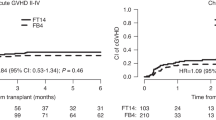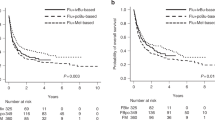Abstract
Allogeneic stem-cell transplantation (SCT) is a potentially curative therapy for lymphoid malignancies. Myeloablative conditioning is associated with high non-relapse mortality (NRM). Reduced-intensity condition (RIC) reduces NRM but relapse rate is increased. Novel regimens with intensive anti-malignancy activity but limited toxicity are of benefit. We evaluated outcomes of 144 lymphoma patients given allogeneic SCT with RIC consisting of fludarabine and treosulfan (FT, n=50), intravenous-busulfan (FB2, n=38) or melphalan (FM, n=56). Sixty-nine patients (48%) had chemo-sensitive disease and 75 (52%) had chemo-refractory disease at SCT. The median follow-up is 39 months (4–149). Three-year survival was 67, 74 and 48% after FT, FB2 and FM, in chemo-sensitive disease (P=0.14) and 34, 11 and 17% in chemo-refractory disease, respectively (P=0.08). Three-year NRM was 24, 24 and 54% (P=0.002), whereas relapse mortality was 22, 34 and 18%, respectively (P=0.13). Multivariate analysis identified a high comorbidity-score, chemo-refractory disease and FM as associated with shortened survival. In conclusion, FB2 is associated with low NRM and good results in chemo-sensitive disease, but with higher relapse mortality rates. FM controls disease better, but with high NRM. FT probably balances these outcomes more optimally. It is as safe as FB2 and as cytoreductive as FM, resulting in improved outcome, mostly in advanced disease.
This is a preview of subscription content, access via your institution
Access options
Subscribe to this journal
Receive 12 print issues and online access
$259.00 per year
only $21.58 per issue
Buy this article
- Purchase on Springer Link
- Instant access to full article PDF
Prices may be subject to local taxes which are calculated during checkout



Similar content being viewed by others
References
Philip T, Guglielmi C, Hagenbeek A, Somers R, Van der Lelie H, Bron D et al. Autologous bone marrow transplantation as compared with salvage chemotherapy in relapses of chemotherapy-sensitive non-Hodgkin's lymphoma. N Engl J Med 1995; 333: 1540–1545.
van Besien K . Current status of allogeneic transplantation for aggressive non-Hodgkin lymphoma. Curr Opin Oncol 2011; 23: 681–691.
Dhedin N, Giraudier S, Gaulard P, Esperou H, Ifrah N, Michallet M et al. Allogeneic bone marrow transplantation in aggressive non-Hodgkin's lymphoma (excluding Burkitt and lymphoblastic lymphoma): a series of 73 patients from the SFGM database. Sociét Française de Greffe de Moelle. Br J Haematol 1999; 107: 154–161.
Kim SW, Tanimoto TE, Hirabayashi N, Goto S, Kami M, Yoshioka S et al. Myeloablative allogeneic hematopoietic stem cell transplantation for non-Hodgkin lymphoma: a nationwide survey in Japan. Blood 2006; 108: 382–389.
van Besien K, Sobocinski KA, Rowlings PA, Murphy SC, Armitage JO, Bishop MR et al. Allogeneic bone marrow transplantation for low-grade lymphoma. Blood 1998; 92: 1832–1836.
Freytes CO, Loberiza FR, Rizzo JD, Bashey A, Bredeson CN, Cairo MS et al. Myeloablative allogeneic hematopoietic stem cell transplantation in patients who experience relapse after autologous stem cell transplantation for lymphoma: a report of the International Bone Marrow Transplant Registry. Blood 2004; 104: 3797–3803.
Milpied N, Fielding AK, Pearce RM, Ernst P, Goldstone AH . Allogeneic bone marrow transplant is not better than autologous transplant for patients with relapsed Hodgkin's disease. European Group for Blood and Bone Marrow Transplantation. J Clin Oncol 1996; 14: 1291–1296.
Gajewski JL, Phillips GL, Sobocinski KA, Armitage JO, Gale RP, Champlin RE et al. Bone marrow transplants from HLA-identical siblings in advanced Hodgkin's disease. J Clin Oncol 1996; 14: 572–578.
Tsai T, Goodman S, Saez R, Schiller G, Adkins D, Callander N et al. Allogeneic bone marrow transplantation in patients who relapse after autologous transplantation. Bone Marrow Transplant 1997; 20: 859–863.
Radich JP, Gooley T, Sanders JE, Anasetti C, Chauncey T, Appelbaum FR . Second allogeneic transplantation after failure of first autologous transplantation. Biol Blood Marrow Transplant 2000; 6: 272–279.
McClune BL, Ahn KW, Wang HL, Antin JH, Artz AS, Cahn JY et al. Allotransplantation for patients age ⩾40 years with non-Hodgkin lymphoma: encouraging progression-free survival. Biol Blood Marrow Transplant 2014; 20: 960–968.
Nagler A, Slavin S, Varadi G, Naparstek E, Samuel S, Or R . Allogeneic peripheral blood stem cell transplantation using a fludarabine-based low intensity conditioning regimen for malignant lymphoma. Bone Marrow Transplant 2000; 25: 1021–1028.
Robinson SP, Goldstone AH, Mackinnon S, Carella A, Russell N, de Elvira CR et al. Chemoresistant or aggressive lymphoma predicts for a poor outcome following reduced-intensity allogeneic progenitor cell transplantation: an analysis from the Lymphoma Working Party of the European Group for Blood and Bone Marrow Transplantation. Blood 2002; 100: 4310–4316.
Rezvani AR, Storer B, Maris M, Sorror ML, Agura E, Maziarz RT et al. Nonmyeloablative allogeneic hematopoietic cell transplantation in relapsed, refractory, and transformed indolent non-Hodgkin's lymphoma. J Clin Oncol 2008; 26: 211–217.
Khouri IF, Saliba RM, Erwin WD, Samuels BI, Korbling M, Medeiros LJ et al. Nonmyeloablative allogeneic transplantation with or without 90yttrium ibritumomab tiuxetan is potentially curative for relapsed follicular lymphoma: 12-year results. Blood 2012; 119: 6373–6378.
Thomson KJ, Morris EC, Bloor A, Cook G, Milligan D, Parker A et al. Favorable long-term survival after reduced-intensity allogeneic transplantation for multiple-relapse aggressive non-Hodgkin's lymphoma. J Clin Oncol 2009; 27: 426–432.
Sirvent A, Dhedin N, Michallet M, Mounier N, Faucher C, Yakoub-Agha I et al. Low nonrelapse mortality and prolonged long-term survival after reduced-intensity allogeneic stem cell transplantation for relapsed or refractory diffuse large B cell lymphoma: report of the Société Française de Greffe de Moelle et de Thérapie Cellulaire. Biol Blood Marrow Transplant 2010; 16: 78–85.
Pasquini MC, Wang Z . Current use and outcome of hematopoietic stem cell transplantation: CIBMTR Summary Slides, 2013. Available at: http://www.cibmtr.org.
Shimoni A, Nagler A . Optimizing the conditioning regimen for allogeneic stem-cell transplantation in acute myeloid leukemia; dose intensity is still in need. Best Pract Res Clin Haematol 2011; 24: 369–379.
Rodriguez R, Nademanee A, Ruel N, Smith E, Krishnan A, Popplewell L et al. Comparison of reduced-intensity and conventional myeloablative regimens for allogeneic transplantation in non-Hodgkin's lymphoma. Biol Blood Marrow Transplant 2006; 12: 1326–1334.
Bacher U, Klyuchnikov E, Le-Rademacher J, Carreras J, Armand P, Bishop MR et al. Conditioning regimens for allotransplants for diffuse large B-cell lymphoma: myeloablative or reduced intensity? Blood 2012; 120: 4256–4262.
Hamadani M, Saber W, Ahn KW, Carreras J, Cairo MS, Fenske TS et al. Allogeneic hematopoietic cell transplantation for chemotherapy-unresponsive mantle cell lymphoma: a cohort analysis from the center for international blood and marrow transplant research. Biol Blood Marrow Transplant 2013; 19: 625–631.
van Kampen RJ, Canals C, Schouten HC, Nagler A, Thomson KJ, Vernant JP et al. Allogeneic stem-cell transplantation as salvage therapy for patients with diffuse large B-cell non-Hodgkin'slymphoma relapsing after an autologous stem-cell transplantation: an analysis of the European Group for Blood and Marrow Transplantation Registry. J Clin Oncol 2011; 29: 1342–1348.
Rigacci L, Puccini B, Dodero A, Iacopino P, Castagna L, Bramanti S et al. Allogeneic hematopoietic stem cell transplantation in patients with diffuse large B cell lymphoma relapsed after autologous stem cell transplantation: a GITMO study. Ann Hematol 2012; 91: 931–939.
Hari P, Carreras J, Zhang MJ, Gale RP, Bolwell BJ, Bredeson CN et al. Allogeneic transplants in follicular lymphoma: higher risk of disease progression after reduced-intensity compared to myeloablative conditioning. Biol Blood Marrow Transplant 2008; 14: 236–245.
Sureda A, Robinson S, Canals C, Carella AM, Boogaerts MA, Caballero D et al. Reduced-intensity conditioning compared with conventional allogeneic stem-cell transplantation in relapsed or refractory Hodgkin's lymphoma: an analysis from the Lymphoma Working Party of the European Group for Blood and Marrow Transplantation. J Clin Oncol 2008; 26: 455–462.
Munkelt D, Koehl U, Kloess S, Zimmermann SY, Kalaaoui RE, Wehner S et al. Cytotoxic effects of treosulfan and busulfan against leukemic cells of pediatric patients. Cancer Chemother Pharmacol 2008; 62: 821–830.
Danylesko I, Shimoni A, Nagler A . Treosulfan -based conditioning before hematopoietic SCT: more than a BU look-alike. Bone Marrow Transplant 2012; 47: 5–14.
Shimoni A, Shem-Tov N, Volchek Y, Danylesko I, Yerushalmi R, Nagler A . Allo-SCT for AML and MDS with treosulfan compared with BU-based regimens: reduced toxicity vs reduced intensity. Bone Marrow Transplant 2012; 47: 1274–1282.
Koenigsmann M, Casper J, Kahl C, Basara N, Sayer HG, Behre G et al. Risk-adapted, treosulfan-based therapy with auto- and allo-SCT for relapsed/refractory aggressive NHL: a prospective phase-II trial. Bone Marrow Transplant 2014; 49: 410–415.
Schmitt M, Trenschel R, Sayer HG, Schneider C, Glass A, Hilgendorf I et al. Conditioning with treosulfan and fludarabine for patients with refractory or relapsed non-Hodgkin lymphoma. Mol Clin Oncol 2014; 2: 773–782.
Shimoni A, Hardan I, Shem-Tov N, Rand A, Herscovici C, Yerushalmi R et al. Comparison between two fludarabine-based reduced-intensity conditioning regimens before allogeneic hematopoietic stem-cell transplantation: fludarabine/melphalan is associated with higher incidence of acute graft-versus-host disease and non-relapse mortality and lower incidence of relapse than fludarabine/busulfan. Leukemia 2007; 21: 2109–2116.
Sureda A, Bader P, Cesaro S, Dreger P, Duarte RF, Dufour C et al. Indications for allo- and auto-SCT for haematological diseases, solid tumours and immune disorders: current practice in Europe, 2015. Bone Marrow Transplant, e-pub ahead of print 23 Mar 2015; doi:10.1038/bmt.2015.6.
Cheson BD, Pfistner B, Juweid ME, Gascoyne RD, Specht L, Horning SJ et al. Revised response criteria for malignant lymphoma. J Clin Oncol 2007; 25: 579–586.
Kaplan EL, Meier P . Nonparametric estimation from incomplete observations. J Am Stat Assos 1958; 53: 457–481.
Gooley TA, Leisenring W, Crowley J, Storer BE . Estimation of failure probabilities in the presence of competing risks: new representations of old estimators. Stat Med 1999; 18: 695–706.
Bacigalupo A, Ballen K, Rizzo D, Giralt S, Lazarus H, Ho V et al. Defining the intensity of conditioning regimens: working definitions. Biol Blood Marrow Transplant 2009; 15: 1628–1633.
Baron F, Labopin M, Peniket A, Jindra P, Afanasyev B, Sanz MA et al. Reduced-intensity conditioning with fludarabine and busulfan versus fludarabine and melphalan for patients with acute myeloid leukemia: a report from the Acute Leukemia Working Party of the European Group for Blood and Marrow Transplantation. Cancer 2015; 121: 1048–1055.
Sjoo F, Hassan Z, Abedi-Valugerdi M, Griskevicius L, Nilsson C, Remberger M et al. Myeloablative and immunosuppressive properties of treosulfan in mice. Exp Hematol 2006; 34: 115–121.
Hilgendorf I, Wolff D, Gromke T, Trenschel R, Elmaagacli AH, Pichlmeier U et al. Retrospective analysis of treosulfan-based conditioning in comparison with standard conditioning in patients with myelodysplastic syndrome. Bone Marrow Transplant 2011; 46: 502–509.
Vose JM, Bierman PJ, Anderson JR, Kessinger A, Pierson J, Nelson J et al. Progressive disease after high-dose therapy and autologous transplantation for lymphoid malignancy: clinical course and patient follow-up. Blood 1992; 80: 2142–2148.
Paltiel O, Rubinstein C, Or R, Nagler A, Gordon L, Deutsch L et al. Factors associated with survival in patients with progressive disease following autologous transplant for lymphoma. Bone Marrow Transplant 2003; 31: 565–569.
Sureda A, Pereira MI, Dreger P, Lymphoma Working Party of the European Group for Blood and Marrow Transplantation. The role of hematopoietic stem cell transplantation in the treatment of relapsed/refractory Hodgkin's lymphoma. Curr Opin Oncol 2012; 24: 727–732.
Sorror ML, Storer BE, Maloney DG, Sandmaier BM, Martin PJ, Storb R . Outcomes after allogeneic hematopoietic cell transplantation with nonmyeloablative or myeloablative conditioning regimens for treatment of lymphoma and chronic lymphocytic leukemia. Blood 2008; 111: 446–452.
Author information
Authors and Affiliations
Corresponding author
Ethics declarations
Competing interests
AN received research grant, honorarium, travel grants and participated in advisory board of Medac, Hamburg, Germany. AS received travel grants from Medac, Hamburg, Germany.
Rights and permissions
About this article
Cite this article
Yerushalmi, R., Shem-Tov, N., Danylesko, I. et al. Fludarabine and treosulfan compared with other reduced-intensity conditioning regimens for allogeneic stem cell transplantation in patients with lymphoid malignancies. Bone Marrow Transplant 50, 1526–1535 (2015). https://doi.org/10.1038/bmt.2015.174
Received:
Revised:
Accepted:
Published:
Issue Date:
DOI: https://doi.org/10.1038/bmt.2015.174
This article is cited by
-
Fludarabine melphalan versus fludarabine treosulfan for reduced intensity conditioning regimen in allogeneic hematopoietic stem cell transplantation: a retrospective analysis
International Journal of Hematology (2024)
-
Treosulfan plus fludarabine versus TEAM as conditioning treatment before autologous stem cell transplantation for B-cell Non-Hodgkin lymphoma
Bone Marrow Transplantation (2022)
-
Busulfan–fludarabine- or treosulfan–fludarabine-based myeloablative conditioning for children with thalassemia major
Annals of Hematology (2022)



